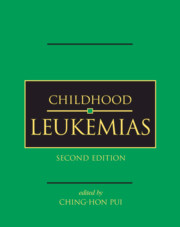Book contents
- Frontmatter
- Contents
- List of contributors
- Preface
- Part I History and general issues
- Part II Cell biology and pathobiology
- 4 Anatomy and physiology of hematopoiesis
- 5 Hematopoietic growth factors
- 6 Signal transduction in the regulation of hematopoiesis
- 7 Immunophenotyping
- 8 Immunoglobulin and T-cell receptor gene rearrangements
- 9 Cytogenetics of acute leukemias
- 10 Molecular genetics of acute lymphoblastic leukemia
- 11 Molecular genetics of acute myeloid leukemia
- 12 Apoptosis and chemoresistance
- 13 Heritable predispositions to childhood hematologic malignancies
- Part III Evaluation and treatment
- Part IV Complications and supportive care
- Index
- Plate Section between pages 400 and 401
- References
8 - Immunoglobulin and T-cell receptor gene rearrangements
from Part II - Cell biology and pathobiology
Published online by Cambridge University Press: 01 July 2010
- Frontmatter
- Contents
- List of contributors
- Preface
- Part I History and general issues
- Part II Cell biology and pathobiology
- 4 Anatomy and physiology of hematopoiesis
- 5 Hematopoietic growth factors
- 6 Signal transduction in the regulation of hematopoiesis
- 7 Immunophenotyping
- 8 Immunoglobulin and T-cell receptor gene rearrangements
- 9 Cytogenetics of acute leukemias
- 10 Molecular genetics of acute lymphoblastic leukemia
- 11 Molecular genetics of acute myeloid leukemia
- 12 Apoptosis and chemoresistance
- 13 Heritable predispositions to childhood hematologic malignancies
- Part III Evaluation and treatment
- Part IV Complications and supportive care
- Index
- Plate Section between pages 400 and 401
- References
Summary
Introduction
The ability of the immune system to specifically recognize millions of different antigens and antigenic epitopes is based on the enormous diversity (at least 10) of antigen-specific receptors, that is, surface membrane-bound immunoglobulin (SmIg) molecules on B lymphocytes and T-cell receptor (TCR) molecules on T lymphocytes. The antigen-specific receptors differ from lymphocyte to lymphocyte, but each single lymphocyte or lymphocyte clone expresses approximately 10 receptors with identical antigen specificity. The extensive diversity of the antigen-specific receptors of lymphocytes is based on rearrangement processes in the Ig/TCR-encoding genes.
Since the various types of lymphoid leukemias resemble normal lymphoid (precursor) cells, most lymphoid leukemias and lymphomas also contain rearranged IG/TCR genes. Being derived from a single malignantly transformed lymphoid cell, all cells of a lymphoid malignancy have their IG/TCR genes rearranged in an identical way. This information can be readily employed for clonality assessment in lymphoproliferations. We will discuss the IG/TCR gene rearrangement processes and the methods for detecting clonal IG/TCR gene rearrangements in various types of (childhood) leukemia. Finally, several applications of diagnostic clonality studies in childhood leukemia are presented.
IG/TCR gene rearrangement processes
Ig molecules and their encoding genes
Ig molecules consist of two disulfide-bonded Ig heavy (IgH) chains and two Ig light chains. The Ig class or subclass is determined by the isotype of the involved IgH chain, irrespective of the type of light chain. Each B lymphocyte or B-lymphocyte clone expresses only one type of light chain (Igκ or Igλ), whereas multiple IgH chains can be expressed.
- Type
- Chapter
- Information
- Childhood Leukemias , pp. 210 - 234Publisher: Cambridge University PressPrint publication year: 2006
References
- 2
- Cited by



